Strong Electromagnetic Interference and Protection in UAVs
Abstract
:1. Introduction
2. Effects of Strong Electromagnetic Environments on the UAV
2.1. Effect of Strong Electromagnetism on the Datalink System
2.2. Effect of Strong Electromagnetism on the Flight Control and Navigation System
2.3. Effect of Strong Electromagnetism on the Power System
3. Methods for the Study of Strong Electromagnetic Effects on the UAV
3.1. Test Research
- Irradiation test: The EUT is directly exposed to the strong electromagnetic irradiation field. This method simulates electromagnetic fields in the real environment and can evaluate the performance and tolerance of devices in such scenarios.
- Injection test: High current or high voltage is directly injected or applied to the EUT, and it should be ensured that the waveform of the injected signal is consistent with the actual situation.
3.1.1. Irradiation Test
3.1.2. Injection Test
3.1.3. Summary
3.2. Simulation Research
4. Protection against Strong EMI for the UAV
4.1. Front-Door Protection Methods
4.1.1. Protection Technologies Based on Surface Electromagnetic Structures
4.1.2. Limiting Technologies
4.2. Back-Door Protection Methods
4.2.1. Shielding Protection
4.2.2. Conduction Protection
4.3. New Technologies of Strong Electromagnetic Protection for the UAV
5. Conclusions
- Quantifying test research: The credibility of simulation-based research data is limited, so it is important to improve testing methods to gather measured data and ensure reliability.
- Diversifying monitoring methods: Most existing studies focus on observing obvious phenomena, but strong EMI on electronic systems often manifests as microscopic phenomena. Therefore, there is a need to explore more accurate monitoring methods.
- Systematizing mechanism analysis: While current studies mainly focus on internal component damage, understanding how component damage leads to overall UAV system failure is equally important.
- Developing practical protection methods: Traditional shielding and limiting methods often struggle to meet strong EMI protection requirements. Therefore, it is necessary to consider factors such as cost and effectiveness, and to incorporate more practical and reliable methods into UAV design and production.
Author Contributions
Funding
Data Availability Statement
Conflicts of Interest
Abbreviations
| UAV | unmanned aerial vehicle |
| EISAT | electronic information science and technology |
| MCU | microcontroller unit |
| AI | artificial intelligence |
| EMI | electromagnetic interference |
| EMC | electromagnetic compatibility |
| CW | continuous wave |
| HEMP | high-altitude electromagnetic pulse |
| LEMP | lightning electromagnetic pulse |
| UWB EMP | ultra-wideband electromagnetic pulse |
| HPM | high-power microwave |
| BER | bit error rate |
| AGC | automatic gain control |
| LNA | low-noise amplifier |
| IMU | inertial measurement unit |
| ESC | electronic speed control |
| PWM | pulse width modulation |
| PCB | printed circuit board |
| EUT | equipment under test |
| FDTD | finite difference time domain |
| FIT | finite integration technique |
| FEM | finite element method |
| MOM | method of moments |
| FSS | frequency selective surface |
| ESS | energy selective surface |
| GDT | gas discharge tube |
| MOV | metal oxide varistor |
| TVS | transient voltage suppression |
References
- Li, B.; Fei, Z.; Zhang, Y. UAV Communications for 5G and Beyond: Recent Advances and Future Trends. IEEE Internet Things J. 2019, 6, 2241–2263. [Google Scholar] [CrossRef]
- Luo, Y.; Yu, X.; Yang, D.; Zhou, B. A survey of intelligent transmission line inspection based on unmanned aerial vehicle. Artif. Intell. Rev. 2022, 56, 173–201. [Google Scholar] [CrossRef]
- Selvaraj, R.; Kuthadi, V.M.; Baskar, S. Real-time agricultural field monitoring and smart irrigation architecture using the internet of things and quadrotor unmanned aerial vehicles. Agron. J. 2022, 115, 1–20. [Google Scholar] [CrossRef]
- Lyu, M.; Zhao, Y.; Huang, C.; Huang, H. Unmanned Aerial Vehicles for Search and Rescue: A Survey. Remote Sens. 2023, 15, 3266. [Google Scholar] [CrossRef]
- Motlagh, N.H.; Kortoçi, P.; Su, X.; Lovén, L.; Hoel, H.K.; Haugsvær, S.B.; Srivastava, V.; Gulbrandsen, C.F.; Nurmi, P.; Tarkoma, S. Unmanned Aerial Vehicles for Air Pollution Monitoring: A survey. IEEE Internet Things J. 2023, 10, 21687–21704. [Google Scholar]
- Peddinti, P.R.T.; Puppala, H.; Kim, B. Pavement Monitoring Using Unmanned Aerial Vehicles: An Overview. J. Transp. Eng. B Pavements 2023, 149, 03123002. [Google Scholar] [CrossRef]
- Li, Y.; Ding, Q.; Li, K.; Valtchev, S.; Li, S.; Yin, L. A Survey of Electromagnetic Influence on UAVs from an EHV Power Converter Stations and Possible Countermeasures. Electronics 2021, 10, 701. [Google Scholar] [CrossRef]
- Fei, C.; Wei, X.D. Summary of Research on Strong Electromagnetic Pulse Effect in Radar Receiver. Sci. J. Intell. Syst. Res. 2021, 3, 155–161. [Google Scholar]
- Giri, D.V.; Tesche, F.M. Classification of Intentional Electromagnetic Environments (IEME). IEEE Trans. Electromagn. Compat. 2004, 46, 322–328. [Google Scholar]
- Sun, Y.; Li, L.; Wang, W. Discussion on the Safety Engineering of UAV in UHV Transmission Line Routing Inspection. Shandong Electr. Power 2017, 44, 15–19. [Google Scholar]
- Zhu, X.; Lai, J.; Chen, S. Cooperative Location Method for Leader-Follower UAV Formation Based on Follower UAV’s Moving Vector. Sensors 2022, 22, 7125. [Google Scholar]
- Chen, Y.; Zhang, D.; Cheng, E.; Wang, X. Investigation on susceptibility of UAV to radiated IEMI. In Proceedings of the 2018 IEEE International Symposium on Electromagnetic Compatibility and 2018 IEEE Asia-Pacific Symposium on Electromagnetic Compatibility (EMC/APEMC), Suntec City, Singapore, 14–18 May 2018. [Google Scholar]
- Zhang, T.; Chen, Y.; Cheng, E. Continuous wave radiation effects on UAV data link system. In Proceedings of the 2013 Cross Strait Quad-Regional Radio Science and Wireless Technology Conference, Chengdu, China, 21–25 July 2013. [Google Scholar]
- Du, B.; Chen, Y.; Cheng, E.; Zhang, D.; Tian, Q. Experiment Analysis of Continuous Wave Electromagnetic Irradiation Effect for a Certain Type of UAV Data Link. J. Microw. 2018, 34, 86–91, 96. [Google Scholar]
- Du, B.; Chen, Y.; Gao, W.; Liu, L.; Cheng, E.; Zhang, D. Research on Electromagnetic Effect of Unmanned Aerial Vehicle Data Link Based on Injection Method. High Volt. Eng. 2018, 44, 3322–3327. [Google Scholar]
- Zhang, D.; Chen, Y.; Cheng, E.; Zhang, Q. Electromagnetic radiation effects on dynamic datalink of UAV. J. Terahertz Sci. Electron. Inf. Technol. 2020, 18, 643–649. [Google Scholar]
- Xu, T.; Chen, Y.; Wang, Y.; Zhao, M. Research on In-Band Continuous Wave Electromagnetic Interference Effect of Unmanned Aerial Vehicle Data Link. J. Beijing Inst. Technol. 2021, 10, 1084–1094. [Google Scholar]
- Yu Sakharov, K.; Sukhov, A.V.; Ugolev, V.L.; Gurevich, Y.M. Study of UWB Electromagnetic Pulse Impact on Commercial Unmanned Aerial Vehicle. In Proceedings of the 2018 International Symposium on Electromagnetic Compatibility (EMC EUROPE), Amsterdam, The Netherlands, 27–30 August 2018. [Google Scholar]
- Gao, S.; Cheng, E.; Chen, Y.; Wang, Y. Research on ultra-wideband electromagnetic pulse irradiation effect and protection method of Unmanned Aerial Vehicle. J. Phys. Conf. Ser. 2019, 1325, 012165. [Google Scholar]
- Zhang, D.; Zhou, X.; Cheng, E.; Wan, H.; Chen, Y. Investigation on Effects of HPM Pulse on UAV’s Datalink. IEEE Trans. Electromagn. Compat. 2020, 62, 829–839. [Google Scholar] [CrossRef]
- Gao, C.; Xue, Z.; Li, W.; Ren, W. The influence of electromagnetic interference of HPM on UAV. In Proceedings of the 2021 International Conference on Microwave and Millimeter Wave Technology (ICMMT), Nanjing, China, 23–26 May 2021. [Google Scholar]
- Jia, Y.; Tu, X.; Yan, W.; Wang, E.; Zhao, Y.; Ding, S. Study on the Influence of Electromagnetic Pulse on UAV Communication Link. Am. J. Electr. Electron Eng. 2019, 7, 42–48. [Google Scholar] [CrossRef]
- Zhang, D.; Chen, Y.; Tian, Q.; Cheng, E. Lightning pulse magnetic field effects on UAV system. High Power Laser Part. Beams 2015, 10, 177–182. [Google Scholar]
- Zhao, M.; Wu, W.; Li, J.; Cheng, Y.; Ma, L.; Guo, J.; Liu, Y. Effect of High Altitude Electromagnetic Pulse on Flight Control System of Typical UAV. Mod. Appl. Phys. 2018, 9, 73–76+83. [Google Scholar]
- Lubkowski, G.; Lanzrath, M.; Lavau, L.C.; Suhrke, M. Response of the UAV Sensor System to HPEM Attacks. In Proceedings of the 2020 International Symposium on Electromagnetic Compatibility—EMC EUROPE, Rome, Italy, 23–25 September 2020. [Google Scholar]
- Wen, Y.; Yuan, S.; Yan, Z. Intense Electromagnetic Pulse Test for Fixed Wing Aircraft. Electron Inf. Warf. Technol. 2021, 36, 70–73. [Google Scholar]
- Fan, L.; Pan, X.; Huang, Z.; Zu, X. The mechanism and experimental study on the interference of high voltage lines to navigation system. Lat. Am. Appl. Res. 2018, 48, 175–179. [Google Scholar] [CrossRef]
- He, K.; Yu, D.; Guo, B.; Chai, M.; Zhou, C.; Zhang, D. An Equivalent Dynamic Test System for Immunity Characterization of the UAV Positioning Module Using Bulk Current Injection Method. IEEE Lett. Electromagn. Compat. Pract. Appl. 2020, 2, 161–164. [Google Scholar]
- Torrero, L.; Mollo, P.; Molino, A.; Perotti, A. RF immunity testing of an Unmanned Aerial Vehicle platform under strong EM field conditions. In Proceedings of the 2013 7th European Conference on Antennas and Propagation (EuCAP), Gothenburg, Sweden, 8–12 April 2013. [Google Scholar]
- Fan, Y.; Cheng, E.; Wei, M.; Zhang, Q.; Chen, Y. Effects of CW Interference on the BDS Receiver and Analysis on the Coupling Path of Electromagnetic Energy. IEEE Access 2019, 7, 155885–155893. [Google Scholar] [CrossRef]
- Zhang, Q.; Cheng, E.; Wang, Y.; Chen, Y.; Ma, L. Research on the electromagnetic interference effect of UAV satellite navigation system. J. Syst. Eng. Electron. 2020, 42, 2684–2691. [Google Scholar]
- Zhang, W.; Shi, Y.; He, Y.; Shen, J.; Pan, X.; Fang, Z.; Chen, H. Study on damage effects of lightning electromagnetic pulse on typical airborne GPS module. High Power Laser Part. Beams 2021, 33, 22–28. [Google Scholar]
- Zhang, J.; He, Y.; Pan, X.; Qiao, Z.; Chen, H.; Shen, J.; Yang, Z. Vulnerability Analysis of UAV Against Mesoband Electromagnetic Pulse. J. Proj. Rocket Missiles Guid. 2020, 40, 110–115, 120. [Google Scholar]
- Zhao, T.; Yu, D.; Zhou, D.; Chai, M.; He, K.; Zhou, C.; Wei, J. Ultra-wide spectrum electromagnetic pulse effect and experimental analysis of UAV GPS receiver. High Power Laser Part. Beams 2019, 31, 49–53. [Google Scholar]
- Yu, D.; He, K.; Guo, B.; Lei, S.; Chai, M.; Wang, D.; Tian, Z. Failure process and mechanism of irradiation interference in unmanned aerial vehicle positioning system. High Power Laser Part. Beams 2023, 35, 46–54. [Google Scholar]
- MÅnsson, D.; Thottappillil, R.; Nilsson, T.; LundÉn, O.; BÄckstrÖm, M. Susceptibility of Civilian GPS Receivers to Electromagnetic Radiation. IEEE Trans. Electromagn. Compat. 2008, 50, 434–437. [Google Scholar] [CrossRef]
- Baek, J.; Yoo, S.; Kim, S.Y. Jamming Effect Analysis of Two Chinese GNSS BeiDou-II Civil Signals. Int. J. Electr. Comput. Eng. 2012, 2, 840–845. [Google Scholar] [CrossRef]
- Su, B.; Cao, H. Study on the Power Limiter under Strong Electromagnetic Field of Beidou Navigation Receiver. In Proceedings of the 2019 IEEE 6th International Symposium on Electromagnetic Compatibility (ISEMC), Nanjing, China, 1–4 November 2019. [Google Scholar]
- Huang, X.; Chen, Y.; Wang, Y. Simulation of Interference Effects of UWB Pulse Signal to the GPS Receiver. Discret. Dyn. Nat. Soc. 2021, 2021, 9935543. [Google Scholar]
- Diao, Z.; Wu, G.; Long, X.; Yin, Y.; Tan, J.; Zhou, W.; Liu, G. Jamming Analysis and Experimental Validation of GPS Deception Signal to Electric Patrol UAV. In Proceedings of the 2023 6th International Conference on Energy, Electrical and Power Engineering (CEEPE), Guangzhou, China, 12–14 May 2023. [Google Scholar]
- Mishra, A.; Pal, S.; Singh, P. Design and analysis of an Eight Rotor Co-Axial UAV using carbon fiber composites. Mater. Today Proc. 2022, 68, 1011–1015. [Google Scholar]
- Efe, M.Ö. Battery power loss compensated fractional order sliding mode control of a quadrotor UAV. Asian J. Control 2011, 14, 413–425. [Google Scholar]
- Ye, Z.; Ru, M.; Wu, X. Crosstalk Analysis of Printed Circuit Board Traces with Right-Angled Bent Corners via Time Domain Hybrid Method. IEEE Trans. Electromagn. Compat. 2022, 64, 2227–2237. [Google Scholar] [CrossRef]
- Qiao, Z.; Pan, X.; He, Y.; Chen, H.; Shen, J.; Ye, C. Damage of high power electromagnetic pulse to unmanned aerial vehicles. High Power Laser Part. Beams 2017, 29, 61–66. [Google Scholar]
- Heggo, M.; Mohammed, A.; Melecio, J.; Kabbabe, K.; Tuohy, P.; Watson, S.; Durovic, S. The Operation of UAV Propulsion Motors in the Presence of High External Magnetic Fields. Robotics 2021, 10, 79. [Google Scholar] [CrossRef]
- Mao, Q.; Xiang, Z.; Huang, L.; Meng, J.; Wang, H.; Yang, C.; Cui, Y. High-Power Microwave Pulse-Induced Failure on Unmanned Aerial Vehicle System. IEEE Trans. Plasma Sci. 2023, 51, 1885–1893. [Google Scholar]
- Zhao, M.; Chen, Y.; Zhou, X.; Zhang, D.; Nie, Y. Investigation on Falling and Damage Mechanisms of UAV Illuminated by HPM Pulses. IEEE Trans. Electromagn. Compat. 2022, 64, 1412–1422. [Google Scholar]
- IEC 61000-4-3:2020; Electromagnetic Compatibility (EMC)—Part 4-3: Testing and Measurement Techniques—Radiated, Radio-Frequency, Electromagnetic Field Immunity Test. International Electrotechnical Commission: London, UK, 2020.
- MIL−STD−461G, 2015; Requirements for the Control of Electromagnetic Interference Characteristics of Subsystems and Equipment. NASA Organization: Washington, DC, USA, 2015.
- MIL-STD-464D, 2020; Electromagnetic Environmental Effects Requirements for Systems. NASA Organization: Washington, DC, USA, 2020.
- DO-160G, 2010; Environmental Conditions and Test Procedures for Airborne Equipment. RTCA: Washington, DC, USA, 2010.
- Wei, G.; Lu, X.; Pan, X. Recent Progress and Development in Test Methods for High Intensity Electromagnetic Field Radiation Effect. High Volt. Eng. 2016, 42, 1347–1355. [Google Scholar]
- Pignari, S.; Canavero, F.G. Theoretical assessment of bulk current injection versus radiation. IEEE Trans. Electromagn. Compat. 1996, 38, 469–477. [Google Scholar] [CrossRef]
- Sun, J.; Pan, X.; Lu, X.; Wan, H.; Wei, G. Test Method of Bulk Current Injection for High Field Intensity Electromagnetic Radiated Susceptibility into Shielded Wire. IEEE Trans. Electromagn. Compat. 2022, 64, 275–285. [Google Scholar]
- Spadacini, G.; Grassi, F.; Pignari, S.A.; Bisognin, P.; Piche, A. Bulk current injection as an alternative radiated susceptibility test enforcing a statistically quantified overtesting margin. IEEE Trans. Electromagn. Compat. 2018, 60, 1270–1278. [Google Scholar]
- Tan, L.; Li, Z.; Xiang, Y.; Feng, P.; Guo, Y. A critical analysis of the bulk current injection immunity test based on common-mode and differential-mode. Microelectron. Reliab. 2018, 91, 188–193. [Google Scholar] [CrossRef]
- Lu, X.; Wei, G.; Pan, X.; Fan, L.; Wan, H. Dual-port pulsed differential-mode current injection method for high-level electromagnetic pulse radiated susceptibility testing. IET Sci. Meas. Technol. 2016, 10, 505–512. [Google Scholar] [CrossRef]
- Ibeobi, S.; Pan, X. Study of electromagnetic pulse (EMP) effect on surveillance unmanned aerial vehicles (UAVs). J. Mech. Eng. Autom. Control Syst. 2021, 2, 44–53. [Google Scholar] [CrossRef]
- Zhang, T.; Chen, Y.; Tian, Q.; Cheng, E. Continuous-Wave Electromagnetic Radiation Effects of UAV. J. Microw. 2014, 30, 19–22. [Google Scholar]
- Zhang, D.; Chen, Y.; Tian, Q.; Cheng, E. Mechanism of continuous wave electromagnetic radiation on UAV’s vice telecontrol system. High Power Laser Part. Beams 2015, 27, 189–195. [Google Scholar]
- Carpes, W.P.; Pichon, L.; Razek, A. Analysis of the coupling of an incident wave with a wire inside a cavity using an FEM in frequency and time domains. IEEE Trans. Electromagn. Compat. 2002, 44, 470–475. [Google Scholar] [CrossRef]
- Cheng, E.; Chen, Y.; Liu, W.; Zhang, D.; Li, G. Test method for shielding effectiveness of unmanned aerial vehicle enclosure. High Power Laser Part. Beams 2017, 29, 55–60. [Google Scholar]
- Chen, C.; Yan, W.; Zhao, Y.; Wang, E.; Fu, C.; Ma, R.; Zhu, J. Simulation and analysis of EMP transient electromagnetic effect of aircraft. J. Eng. 2018, 2019, 2464–2467. [Google Scholar] [CrossRef]
- Song, Z.; Yu, B.; Ye, F.; Zhao, J. Research on Electromagnetic Simulation for UAV Focused on Environment Applicability. J. Syst. Simul. 2003, 15, 433–436. [Google Scholar]
- Wen, T.; Song, Q.; Gao, Y. The Analysis about UWB’s EMI Cause to UAV System Based on Matlab/Simulink. In Proceedings of the The 2006 4th Asia-Pacific Conference on Environmental Electromagnetics, Dalian, China, 1–4 August 2006. [Google Scholar]
- Xie, J.; Fu, Q.; Jia, R.; Li, M. Multi-UAV Path Planning under Radar Threats. In Proceedings of the 2023 IEEE International Conference on Smart Internet of Things (SmartIoT), Xining, China, 25–27 August 2023. [Google Scholar]
- Zhang, W.; Ding, W.; Liu, C. Prediction of interference effect on UAV data link in complex environment. Syst. Eng. Electron. 2016, 38, 760–766. [Google Scholar]
- Xu, T.; Chen, Y.; Wang, Y.; Zhang, D.; Zhao, M. EMI Threat Assessment of UAV Data Link Based on Multi-Task CNN. Electronics 2023, 12, 1631. [Google Scholar] [CrossRef]
- Liu, T.; Xu, L.; Li, Q.; Yao, B.; Shi, X. Joint Analysis of Front-Door and Back-Door Couplings of PIN Limiter Based on Improved Equivalent Circuit Model. Electronics 2022, 11, 3921. [Google Scholar]
- Du, X.; Wei, G.; Zhao, H.; Pan, X. Research on Continuous Wave Electromagnetic Effect in Swept Frequency Radar. Math. Probl. Eng. 2021, 2021, 4862451. [Google Scholar]
- Yu, D.; Liu, P.; Dong, Y.; Zhou, Q.; Zhou, D. Active absorptive frequency selective surface. Electron. Lett. 2017, 53, 1087–1088. [Google Scholar] [CrossRef]
- Tan, J.; Dai, X.; Tang, F.; Zhao, M.; Kato, N. Intelligent Configuration Method Based on UAV-Driven Frequency Selective Surface for Communication Band Shielding. IEEE Internet Things J. 2023, 10, 11507–11517. [Google Scholar]
- Wu, Z.; Xu, Y.; Liu, P.; Tian, T.; Lin, M. An Ultra-Broadband Energy Selective Surface Design Method: From Filter Circuits to Metamaterials. IEEE Trans. Antennas Propag. 2023, 71, 5865–5873. [Google Scholar]
- Yang, C.; Liu, P.; Huang, X. A Novel Method of Energy Selective Surface for Adaptive HPM/EMP Protection. IEEE Antennas Wirel. Propag. Lett. 2013, 12, 112–115. [Google Scholar]
- Zhong, S.; Qin, F.; Gao, Y.; Yan, Z. Response Characteristics of Gas Discharge Tube to High-Power Microwave. IEEE Access 2021, 9, 111486–111492. [Google Scholar] [CrossRef]
- Magnusson, J.; Saers, R.; Liljestrand, L.; Engdahl, G. Separation of the energy absorption and overvoltage protection in solid-state breakers by the use of parallel varistors. IEEE Trans. Power Electron. 2014, 29, 2715–2722. [Google Scholar] [CrossRef]
- Kim, S.; Park, J.; Lee, W. Development and Verification of Indirect Lightning-Induced Transient Protection Circuit for Avionics System. Appl. Comput. Electromagn. Soc. J. 2021, 36, 670–675. [Google Scholar]
- Wu, G.; Yue, B.; Yang, Y.; Wang, H.; Cui, Z.; Peng, L.; Wu, W.; Chen, W. High-altitude electromagnetic pulse survivability test study on shortwave receiving antenna system by pulsed current injection. High Power Laser Part. Beams 2019, 31, 79–87. [Google Scholar]
- Xu, F.; Guan, B. Extending Dynamic Range of Receiver with Differential Limiter. Mod. Radar 2009, 31, 78–80, 88. [Google Scholar]
- Wang, Y.; Ma, L.; Chen, Y. Electromagnetic Energy Coupling Path and Protection Method of UAV Datalink against Broad-Spectrum High-Power Microwave Radiation. Radioengineering 2022, 31, 201–209. [Google Scholar] [CrossRef]
- Zheng, S.; Deng, F.; Wang, D.; Hou, D.; Liu, P. Overview of the HPM field-circuit integrated protection methods for electronic equipment and system RF-channels. Chin. J. Ship Res. 2015, 10, 7–14. [Google Scholar]
- Song, S.; Jiang, H.; Huang, Y. Simulation and Analysis of HEMP Coupling Effect on a Wire Inside an Apertured Cylindrical Shielding Cavity. Appl. Comput. Electromagn. Soc. J. 2012, 27, 505–515. [Google Scholar]
- Liang, Y.C.; Chin, P.C.; Sun, Y.P.; Wang, M.R. Design and Manufacture of Composite Landing Gear for a Light Unmanned Aerial Vehicle. Appl. Sci. 2021, 11, 509. [Google Scholar] [CrossRef]
- Ruan, J.; Chang, Z.; Rong, H.; Alomar, T.S.; Zhu, D.; Almasoud, N.; Liao, Y.; Zhao, R.; Zhao, X.; Li, Y.; et al. High-conductivity nickel shells encapsulated wood-derived porous carbon for improved electromagnetic interference shielding. Carbon 2023, 213, 118208. [Google Scholar] [CrossRef]
- Sarkar, B.; Miquet-Westphal, F.; Bobbara, S.; George, B.; Beltrame, G.; Dousset, D.; Wu, K.; Cicoira, F. Electromagnetic interference shielding in lightweight carbon xerogels. Mater. Res. Express 2023, 10, 045601. [Google Scholar] [CrossRef]
- Permata, D.; Gurning, M.C.; Martin, Y.; Sitorus, H.B.H.; Muda, M.A.; Sinaga, H.H. Electromagnetic interference shielding in unmanned aerial vehicle against lightning strike. Telkomnika 2019, 17, 915–919. [Google Scholar] [CrossRef]
- Somolinos, D.R.; Gallardo, B.P.; Estevez, J.C.; Acosta, L.D.; de Francisco, P.G.; Anon-Cancela, M. Shielding Effectiveness Measurement of an UAV Simplified Demonstrator Through Low-Level Swept Field (LLSF) Test. IEEE Trans. Electromagn. Compat. 2022, 64, 1665–1673. [Google Scholar] [CrossRef]
- Kubacki, R.; Przesmycki, R.; Laskowski, D. Shielding Effectiveness of Unmanned Aerial Vehicle Electronics with Graphene-Based Absorber. Electronics 2023, 12, 3973. [Google Scholar] [CrossRef]
- Salameh, M.S.H.A.; Musa, B.A.M. COMSOL solutions to EMI hardening of UAVs against lightning strikes. In Proceedings of the 2023 International Microwave and Antenna Symposium (IMAS), Cairo, Egypt, 7–9 February 2023. [Google Scholar]
- Zhou, C.; Zhang, M. Analysis of the Shielding Effectiveness for Unmanned Aerial Vehicle Fuselage Based on Modal Method of Moments. Int. J. Simul. Syst. Sci. Technol. 2016, 17, 57.1–57.6. [Google Scholar]
- Gassab, O.; Shao, Y.; Su, Z.; He, F.; Zhou, G.; Hong, Z.; He, F.; Meng, J.; Zhao, D.; Yin, W. Coupling Analysis of Shielded and Unshielded Star Quad Cables Excited by an Intentional Electromagnetic Pulse. IEEE Trans. Electromagn. Compat. 2023, 65, 689–704. [Google Scholar] [CrossRef]
- Averin, S.V.; Kirillov, V.Y.; Mashukov, E.V.; Reznikov, S.B.; Shevtsov, D.A. Ensuring the electromagnetic compatibility of onboard cables for unmanned aerial vehicles. Russ. Aeronaut. 2017, 60, 442–446. [Google Scholar] [CrossRef]
- Jo, J.; Kim, Y.; Kim, D.; Lee, H.; Myong, R.S. Effect of Shielding and Drain Wire on Lightning-Induced Currents in Rotorcraft Cables. IEEE Trans. Electromagn. Compat. 2022, 64, 2015–2023. [Google Scholar] [CrossRef]
- Xu, M.; Wang, Y.; Li, X.; Dong, X.; Zhang, H.; Zhao, H.; Shi, X. Analysis of the Influence of the Structural Parameters of Aircraft Braided-Shield Cable on Shielding Effectiveness. IEEE Trans. Electromagn. Compat. 2020, 62, 1028–1036. [Google Scholar] [CrossRef]
- Jiao, Y. Elementary Introduction to Electromagnetic Interference in Cabling of UAVs and Its Countermeasures. Electron. Electro-Optical. Syst. 2009, 1, 36–38. [Google Scholar]
- Wu, Y. EMC Studies of Cables inside the Cabin under Strong Electromagnetic Pulse. Master’s Thesis, Nanjing University of Posts and Telecommunications, Nanjing, China, 2017. [Google Scholar]
- Liang, T.; Spadacini, G.; Grassi, F.; Pignari, S.A. Coupling of Wideband Radiated IEMI to Cables above Ground. IEEE Trans. Electromagn. Compat. 2020, 62, 589–597. [Google Scholar]
- Yuan, X.; Guo, X. Research on a New Kind of DCDC Power Surge Protective Device in Unmanned Aerial Vehicle. Comput. Meas. Control 2011, 19, 1487–1488, 1501. [Google Scholar]
- Du, L.; Li, Y.; Gao, C. Design and Realization of HEMP Conducted Protection Module Testing System. J. Microwaves 2017, 33, 59–62, 79. [Google Scholar]
- Du, C.; Mao, C.; Cui, Z.; Sun, D.; Hao, J.; Wu, W.; Chen, W.; Wu, Z.; Qiu, Y. Design and validation test of high-altitude electromagnetic pulse conductive protector module for wireless communication system. High Power Laser Part. Beams 2021, 33, 73–80. [Google Scholar]
- D Soyaslan, D. High structural insulation composite material development with electromagnetic protection effect reinforced with carbon fibers and particles. J. Ind. Text. 2021, 51, 424–434. [Google Scholar] [CrossRef]
- Chang, X.; Liu, S.; Man, M.; Han, W.; Chu, J.; Yuan, L. Bio-Inspired Electromagnetic Protection Based on Neural Information Processing. J. Bionic Eng. 2014, 11, 151–157. [Google Scholar]
- Li, Y.; Gao, D.; Guo, Y.; Wei, W.; Wang, Y.; Jiang, H.; Peng, F.; Meng, F.; Zhou, Z. A temperature-responsive composite for adaptive microwave absorption. Chem. Eng. J. 2022, 427, 131746. [Google Scholar] [CrossRef]
- Zeng, Y.; Yan, J.; Zhou, Z. Anti-jamming Design of Navigation and Flight Control System Based on DSP. Comput. Meas. Control 2009, 17, 83–84, 134. [Google Scholar]
- Tan, X.; Su, S.; Sun, X. Research on Narrowband Interference Suppression Technology of UAV Network Based on Spread Spectrum Communication. In Proceedings of the 2020 IEEE International Conference on Artificial Intelligence and Information Systems (ICAIIS), Dalian, China, 20–22 March 2020. [Google Scholar]
- Wu, J.; Liu, R.; Zhao, S. The Cognitive Communication based Anti-jamming Method for UAV Swarm Communication. IOP Conf. Ser. Mater. Sci. Eng. 2020, 799, 012043. [Google Scholar] [CrossRef]
- Liu, Y.; Wu, W.; Cheng, Y.; Zhao, M.; Ma, L.; Guo, J. Prediction of Electromagnetic Pulse Irradiation Response Based on Support Vector Machine. J. Phys. Conf. Ser. 2021, 1802, 022010. [Google Scholar]
- Wang, Y.; Ma, L.; Chen, Y. UAV intelligent electromagnetic attack and defense technology. High Power Laser Part. Beams 2021, 33, 151–158. [Google Scholar]
- Zhao, M.; Xu, T.; Cheng, E.; Zhou, X.; Sun, L.; Chen, Y. Mechanism and protection on the data link of UAV exposed to electromagnetic interference. High Power Laser Part. Beams 2021, 33, 49–56. [Google Scholar]
- Xue, R.; Zhao, M. Cognitive-Based High Robustness Frequency Hopping Strategy for UAV Swarms in Complex Electromagnetic Environment. Wirel. Commun. Mob. Comput. 2022, 2022, 4139345. [Google Scholar] [CrossRef]
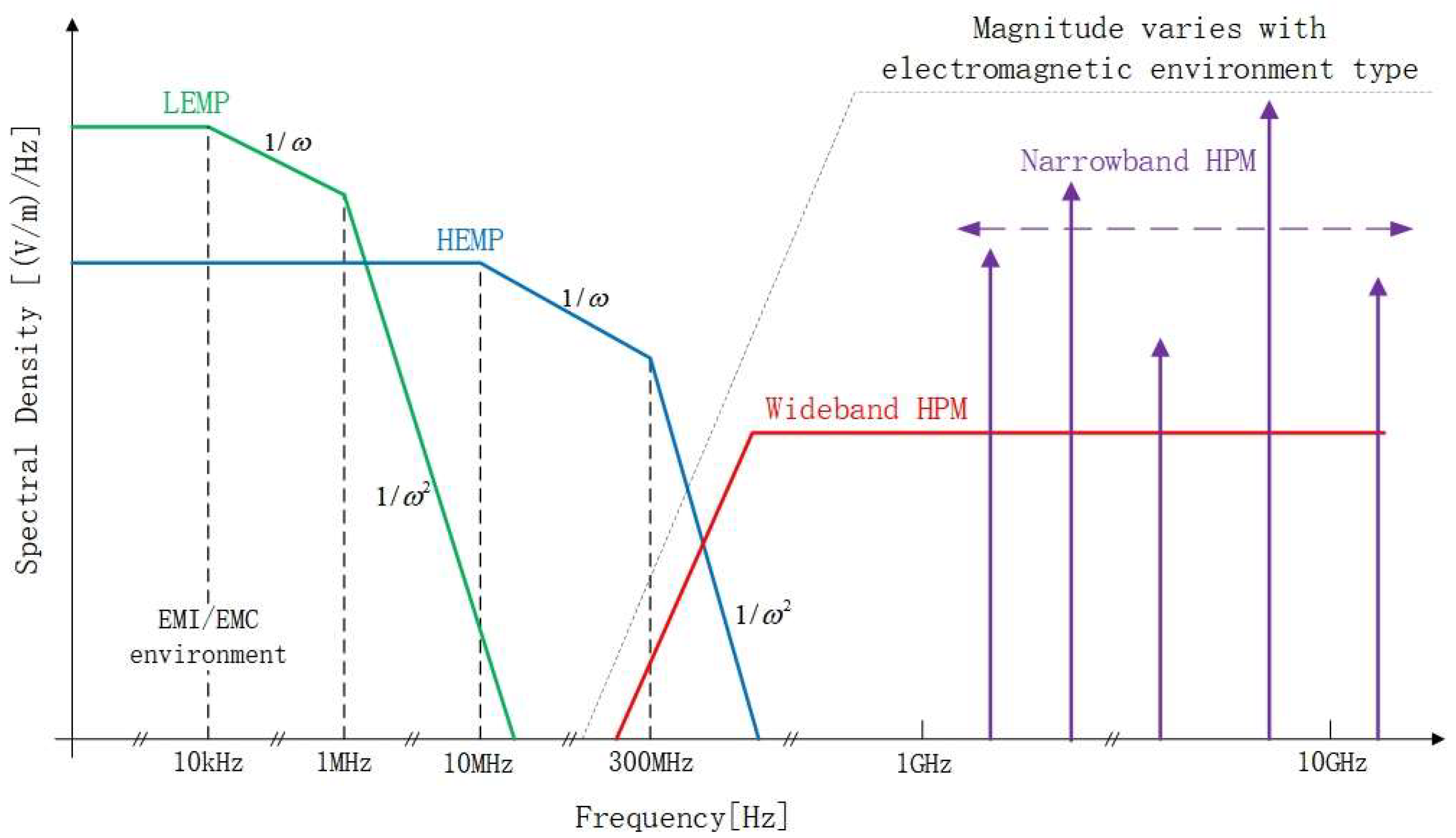

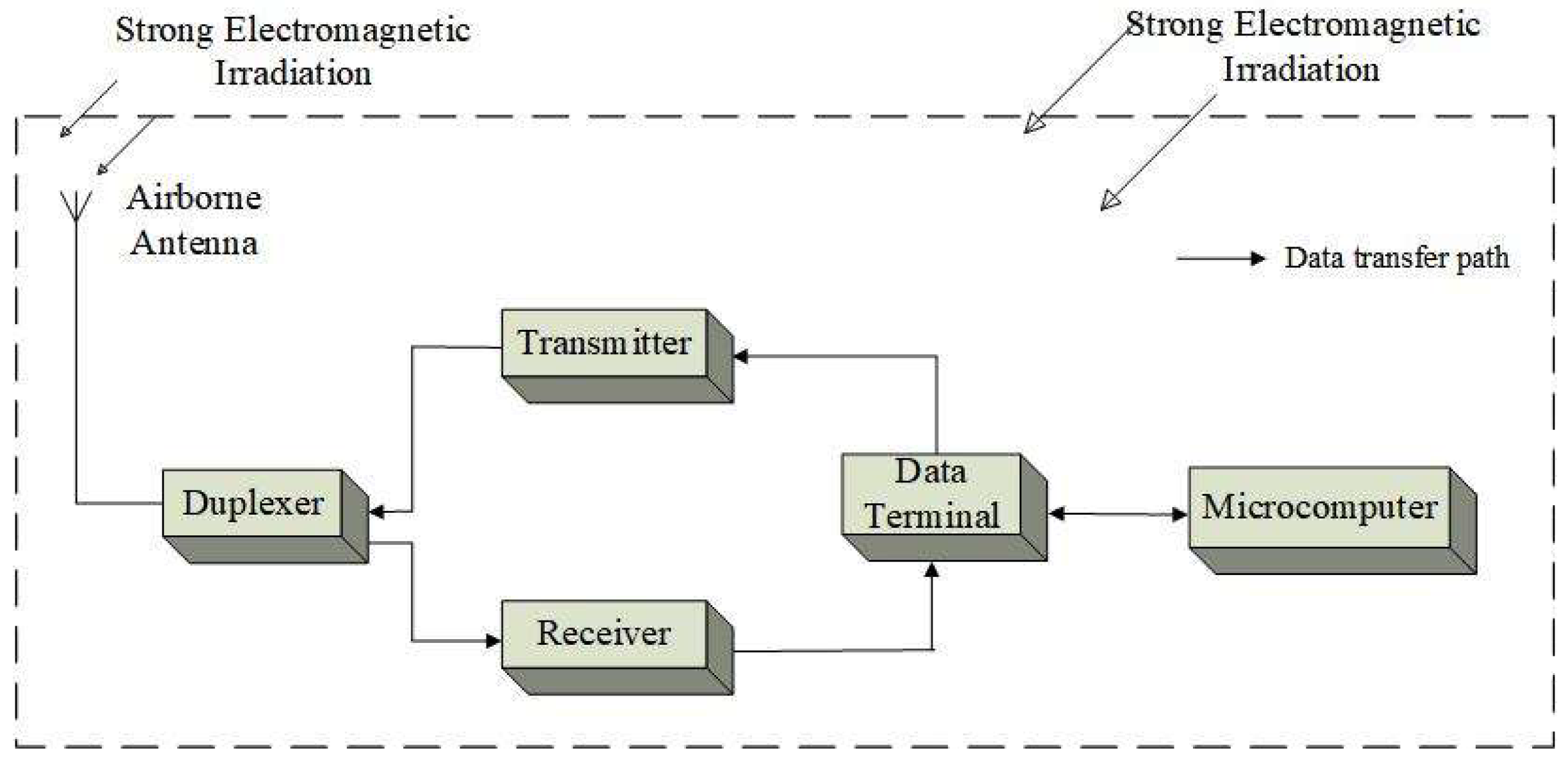

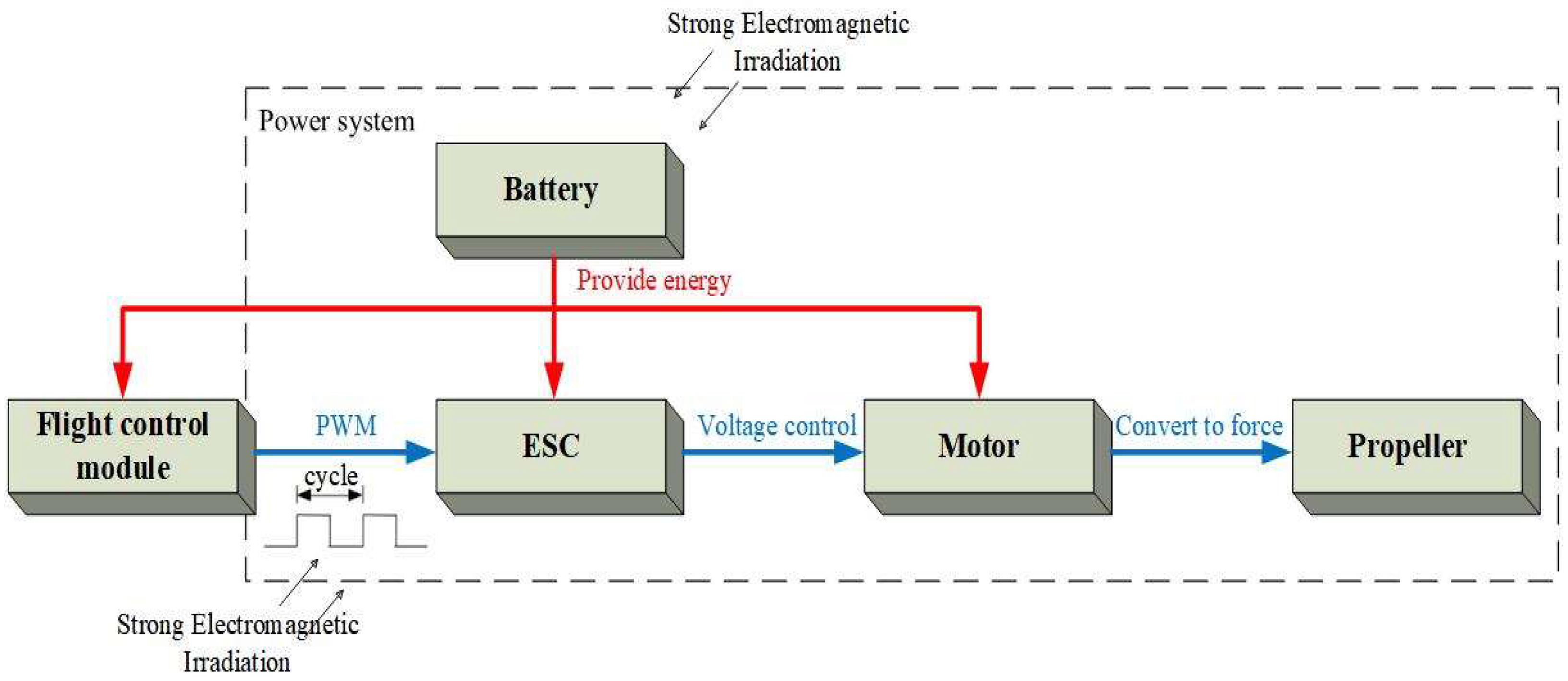


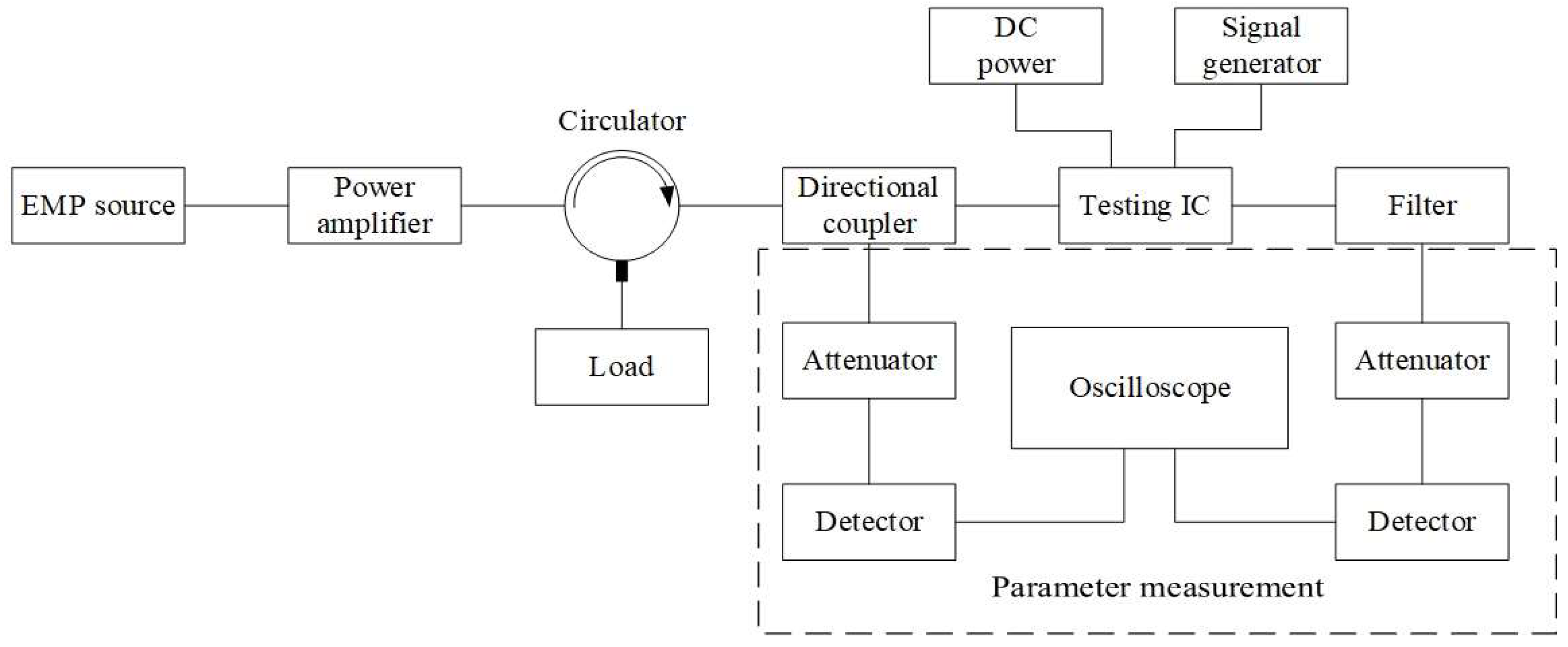
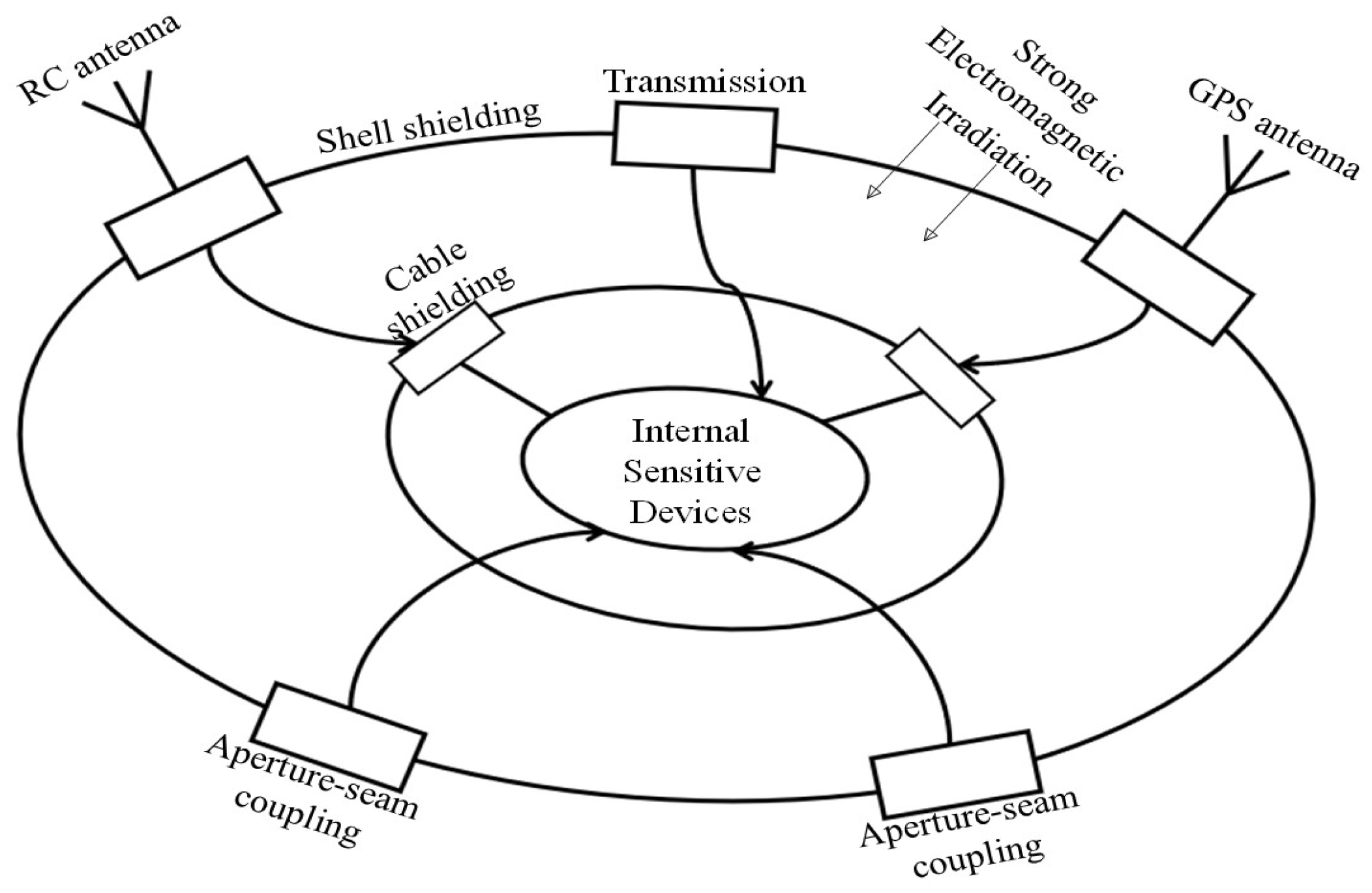
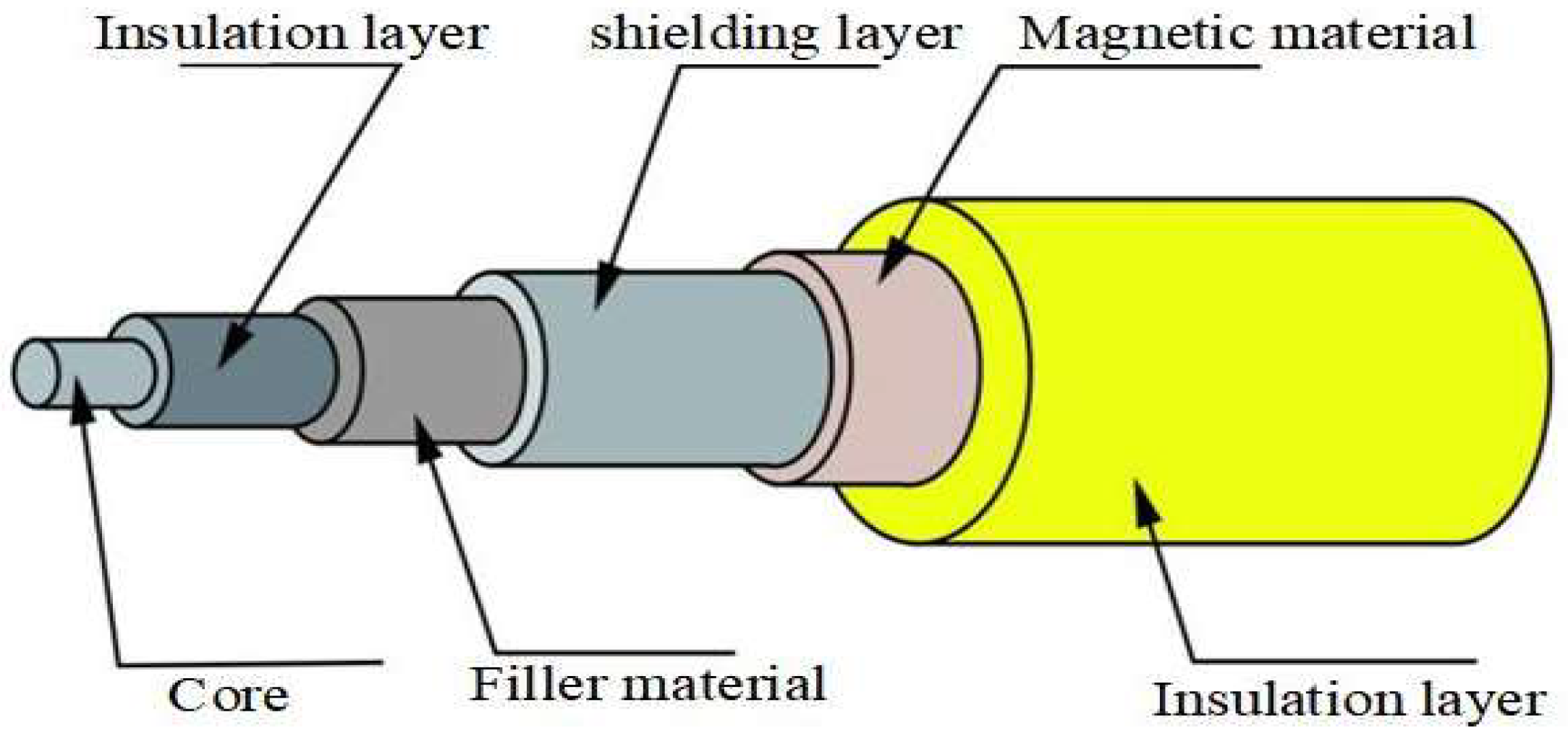
| EMI Classification | Types of EMI |
|---|---|
| Internal EMI | Atmospheric noise |
| Space radiation | |
| LEMP | |
| External EMI | CW |
| HEMP | |
| UWB EMP | |
| HPM |
| Ref. | Objects of Study | Methods | Types of EMI | Results |
|---|---|---|---|---|
| [12] | UAV datalink | Irradiation test Injection test | CW | Interference |
| [13] | UAV datalink | Irradiation test | CW | Interference |
| [14,15] | UAV datalink | Simulation Irradiation test Injection test | CW | Interference |
| [16] | RC-UAV link | Irradiation test | CW | Interference |
| [17] | Receiver | Injection test | CW | Interference |
| [18] | RC-UAV link | Irradiation test | UWB EMP | Interference |
| [19] | Receiver | Irradiation test | UWB EMP | Damage |
| [20] | Receiver | Irradiation test | HPM | Damage |
| [21] | UAV datalink | Simulation | HPM | Interference |
| [22] | Ground station–UAV link | Simulation | Various EMI | Interference |
| Sensors | Functions |
|---|---|
| Gyroscope | Monitors angular velocity in three-axis direction to maintain UAV stability |
| Accelerometer | Monitoring of acceleration and vibration in three-axis direction |
| Barometer | Measuring UAV altitude using atmospheric pressure |
| Magnetic compass | Measuring the Earth’s magnetic field to orientate the UAV |
| Distance sensor | Measure the distance between the UAV and the ground or other obstacles |
| Ref. | Objects of Study | Methods | Types of EMI | Results |
|---|---|---|---|---|
| [23] | Magnetic sensor | Irradiation test | LEMP | Interference |
| [24] | On-board microcomputer | Irradiation test Simulation | HEMP | Interference |
| [25] | Magnetometer | Irradiation test | HPM | Interference |
| [26] | On-board microcomputer | Irradiation test | HPM | Interference |
| [27] | GPS receiver | Theoretical analysis | High voltage electromagnetic field | Interference |
| [28] | GPS receiver Flight control module | Injection test | EMI | Interference |
| [29] | GPS receiver | Irradiation test | EMP | Interference |
| [30] | BeiDou receiver | Simulation Injection test | CW | Interference |
| [31] | GPS module | Injection test | CW | Interference |
| [32] | GPS module | Simulation Injection test | LEMP | Damage |
| [33] | GPS module | Irradiation test | WB EMP | Damage |
| [34] | GPS module | Irradiation test | UWB EMP | Interference |
| [35] | GPS module | Simulation Irradiation test | HPM | Interference |
| Components | Functions |
|---|---|
| Battery | Provides power for UAV, commonly used lithium polymer battery |
| Motor | Energy conversion device that converts electrical energy into mechanical energy |
| ESC | Controls the speed of the motor |
| Propeller | Converts motor rotational power into propulsive force |
| Ref. | Objects of Study | Methods | Types of EMI | Results |
|---|---|---|---|---|
| [44] | ESC | Irradiation test | HPM | Interference |
| [45] | Motor | Irradiation test | Strong magnetic field | Interference |
| [46] | Motor, ESC | Irradiation test | HPM | Damage |
| [47] | ESC | Irradiation test Injection test | HPM | Damage |
| [25] | Motor | Irradiation test | HPM | Interference |
| Test Site | Advantage | Disadvantage |
|---|---|---|
| Outdoor test site | Close to realistic scenarios and lower cost | Vulnerability to the environment |
| TEM chamber | Low frequency and uniform field | EUT size limitation |
| Reverberation chamber | repeatability is better and uncertainty is lower | Frequency dependent on chamber size |
| Anechoic chamber | Not affected by the environment | High cost |
| Algorithm Type | Time Domain | Frequency Domain | ||
|---|---|---|---|---|
| Detailed algorithm | Finite Difference Time Domain (FDTD) | Finite Integration Technique (FIT) | Finite Element Method (FEM) | Method of Moments (MOM) |
| Typical software | XFDTD, EMPro | CST | HFSS, EMPro, JMAG | FEKO, Momentum |
Disclaimer/Publisher’s Note: The statements, opinions and data contained in all publications are solely those of the individual author(s) and contributor(s) and not of MDPI and/or the editor(s). MDPI and/or the editor(s) disclaim responsibility for any injury to people or property resulting from any ideas, methods, instructions or products referred to in the content. |
© 2024 by the authors. Licensee MDPI, Basel, Switzerland. This article is an open access article distributed under the terms and conditions of the Creative Commons Attribution (CC BY) license (https://creativecommons.org/licenses/by/4.0/).
Share and Cite
Zhang, Z.; Zhou, Y.; Zhang, Y.; Qian, B. Strong Electromagnetic Interference and Protection in UAVs. Electronics 2024, 13, 393. https://doi.org/10.3390/electronics13020393
Zhang Z, Zhou Y, Zhang Y, Qian B. Strong Electromagnetic Interference and Protection in UAVs. Electronics. 2024; 13(2):393. https://doi.org/10.3390/electronics13020393
Chicago/Turabian StyleZhang, Zhao, Yang Zhou, Yang Zhang, and Baoliang Qian. 2024. "Strong Electromagnetic Interference and Protection in UAVs" Electronics 13, no. 2: 393. https://doi.org/10.3390/electronics13020393





